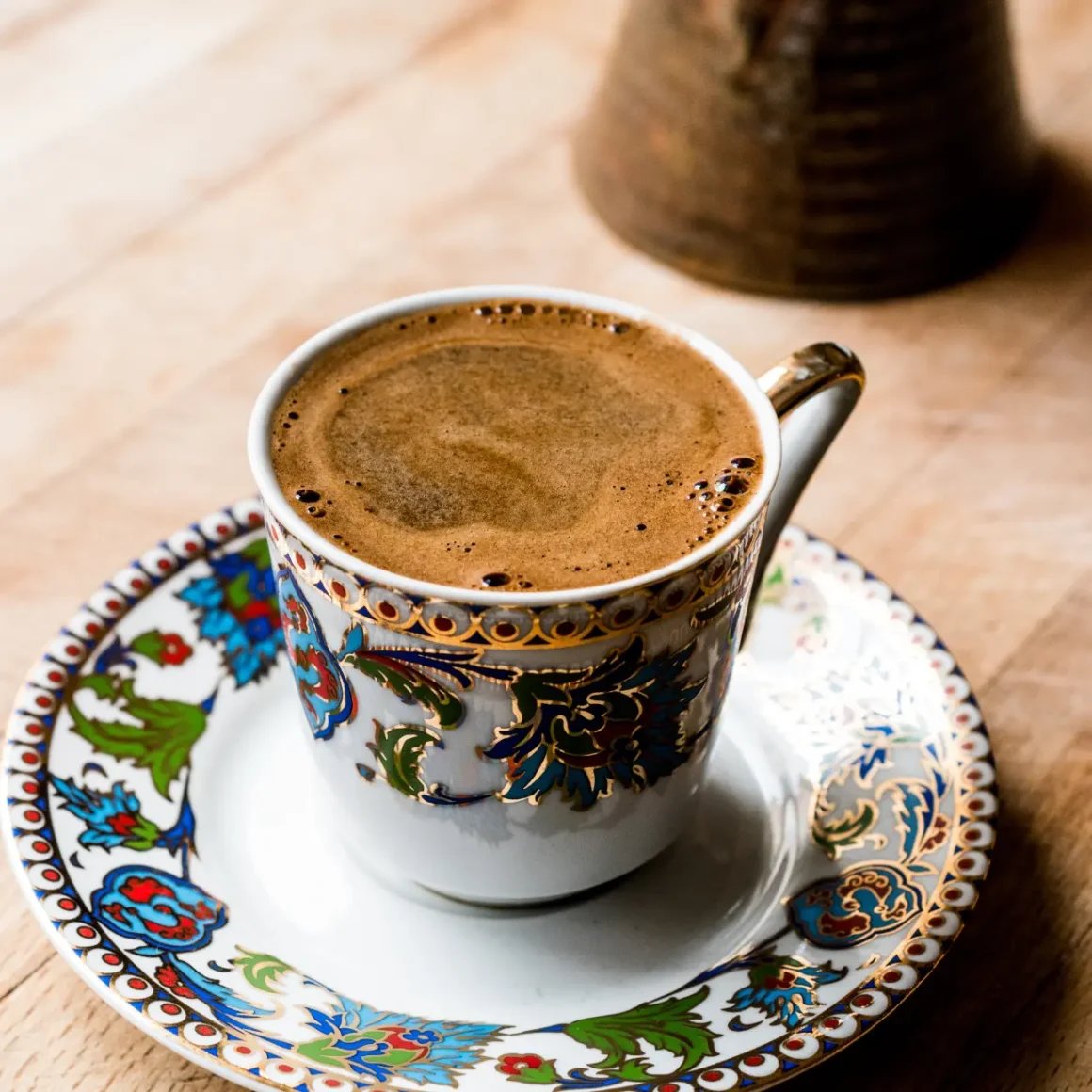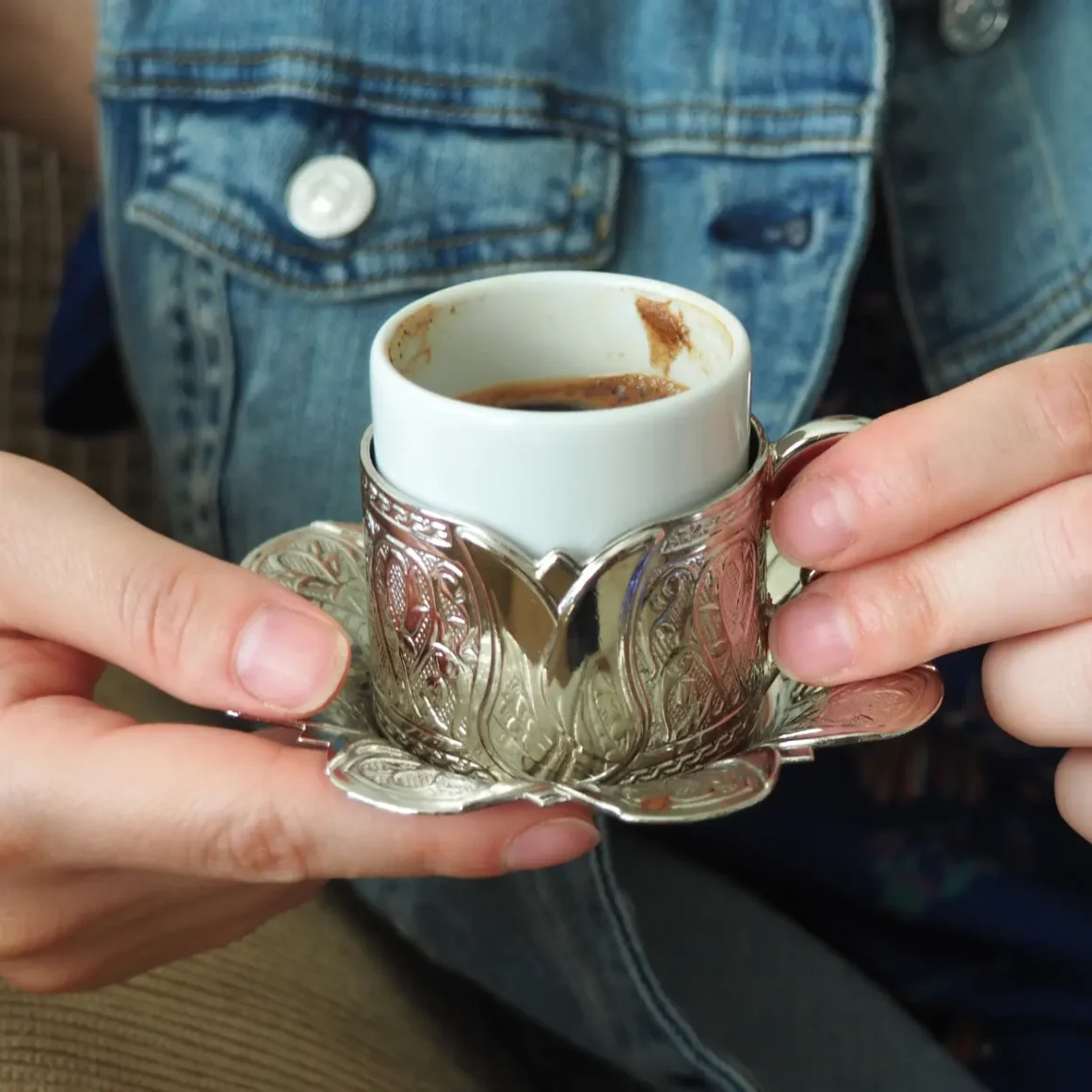In the aromatic world of coffee, few brews carry as much cultural identity and historical richness as Greek and Turkish coffee. Both steeped in tradition and ritual, these coffees are cornerstones of their respective cultures, offering distinct experiences in each sip. The debate about Greek coffee vs Turkish coffee often centers on their differences and similarities, from the finely ground beans and the unique pots used for brewing to the social customs that surround their consumption. This article delves into the nuances of each, exploring the intricate brewing methods, the ceremonial significance, and the evolving global appreciation that has made these coffees beloved far beyond their geographic origins. Join us as we navigate the storied paths of these two iconic beverages, discovering what sets them apart and what unites them in the world of coffee connoisseurs.
Need a break from reading? Listen to the article by clicking below.
- Introduction & Key Differences
- https://app.mysoundwise.com/tracks/16996655479549456e.mp3
- What is Greek Coffee?
- https://app.mysoundwise.com/tracks/16996655897411206e.mp3
- What is Turkish Coffee?
- https://app.mysoundwise.com/tracks/16996656218718784e.mp3
- Brewing Methods
- https://app.mysoundwise.com/tracks/16996656547278164e.mp3
- Flavor Profiles
- https://app.mysoundwise.com/tracks/16996656878580845e.mp3
- Cultural Rituals
- https://app.mysoundwise.com/tracks/16996657190339058e.mp3
- Modern Adaptations
- https://app.mysoundwise.com/tracks/16996657497767676e.mp3
- Historical Background
- https://app.mysoundwise.com/tracks/16996657856889937e.mp3
- Global Appreciation
- https://app.mysoundwise.com/tracks/16996658192025313e.mp3
- Conclusion & FAQs
- https://app.mysoundwise.com/tracks/16996658547216833e.mp3
Turkish Coffee vs Greek Coffee: Key Differences
- Social Essence: Greek coffee is associated with leisurely social gatherings, emphasizing the beverage’s role in fostering community and conversation, while Turkish coffee holds a place of cultural importance with a more ritualized consumption.
- Preparation Vessels: Both Greek and Turkish coffee use a very fine coffee grind; utilizing a specific coffee pot – a briki or a cezve, which is central to the coffee-making process.
- Distinct Flavors: Greek coffee is known for its sweetness and the potential addition of spices, topped with a characteristic creamy foam, whereas Turkish coffee is recognized for its stronger, sometimes bitter taste and its velvety consistency.
- Cultural Significance: In Greece, coffee is a symbol of friendship and cultural traditions, whereas in Turkey, the coffee residue is additionally used in fortune-telling rituals, highlighting coffee’s diverse role in cultural practices and ideologies.
- Historic Appeal: The 16th-century introduction of Turkish coffee into the Ottoman Empire gained prominence under Sultan Suleiman the Magnificent’s endorsement. Conversely, the rise of Greek coffee as a cultural emblem was a response to the geopolitical strains highlighted by the 1974 Turkish invasion of Cyprus.
What is Greek Coffee?

Greek Coffee, known for its robust flavor, is a staple throughout Greece and is integral to the country’s cultural fabric. This traditional beverage is a beloved aspect of Greek life, with its unique preparation and enjoyment deeply rooted in the social customs of the region.
- Distinct Brewing Method: The art of making Greek coffee starts with a special utensil called a briki, a small, brass or copper pot that is essential for creating this distinctive drink. (1) The coffee is made with finely ground beans, which are slowly brewed to perfection, bringing out a strong aroma and flavor that is synonymous with Greek hospitality.
- Customizable Sweetness: One of the hallmarks of Greek coffee is its versatility when it comes to sweetness. Drinkers can tailor the sugar content to their taste, ranging from unsweetened to various levels of sweetness. This personal touch is part of the ritual of preparing Greek coffee, making it a beverage that is truly your own.
- Cultural Significance: Greek coffee is much more than just a morning pick-me-up; it is a social affair meant to be savored. Shared with family and friends, its consumption is often paired with engaging conversation, creating a relaxed atmosphere at gatherings.
- Mediterranean Coffee: Greek coffee also shares its heritage with other Mediterranean coffee traditions, reflecting the rich and diverse coffee culture of the region. Its strong links to communal life and its role in fostering social bonds make it a beverage that is cherished beyond its flavor.
Greek coffee is not just a drink; it’s a cultural experience. Whether enjoyed at home or in the vibrant cafes of Greece, it remains a testament to the country’s tradition of warm hospitality and leisurely social interaction.
What is Turkish Coffee?

Turkish Coffee, a revered and time-honored beverage, is deeply woven into the social and cultural tapestry of regions spanning from Turkey to Iran and Greece. A symbol of Middle Eastern and European traditions, this coffee stands out for its meticulous brewing process and rich cultural significance.
- Traditional Brewing Technique: The authentic Turkish coffee experience begins with the cezve, a traditional coffee pot, although any small pot may be used in its absence. (2) The ultra-fine coffee grounds are combined with water, with the option of sugar, and brought to a near-boil. This precise heating method produces the coffee’s signature froth that is so cherished among connoisseurs.
- Serving Tradition: After heating to the perfect temperature, the coffee, along with the grounds, is served directly into cups. The grounds, heavier than the liquid, naturally settle to the bottom, leaving a clear, flavorful coffee to be enjoyed from above.
- Stronger Flavor and Caffeine: Turkish coffee’s distinct lack of filtration leads to a more potent flavor and higher caffeine concentration, setting it apart from other coffee brewing methods. While it can be served unsweetened, the customary preparation includes a touch of sugar, and occasionally, the fragrant addition of cardamom.
- The Coffee Beans: Historically, Turkish coffee was made using Ethiopian or Yemeni beans during the Ottoman era, similar to Arabic coffee. Today, the preference has shifted to predominantly Arabica beans from Central and South America for Turkish brews, with some blends including Robusta for those who favor a more intense taste.
In essence, Turkish coffee is not just a drink; it is a celebration of cultural heritage, an art form where every sip tells a story of its origins, preparation, and the shared joy it brings to any gathering.
Greek Coffee vs Turkish Coffee: Brewing Methods

The centuries-old traditions of brewing Greek and Turkish coffee are as intricate as they are revered. Each method embodies a cultural narrative steeped in history, offering more than just a cup of coffee but a rich, sensory experience. These methods, while sharing similarities, each have their unique characteristics and techniques.
How to Make Greek Coffee
Creating the perfect Greek coffee is an art form, with attention paid to the minutiae of its preparation, ensuring every sip is imbued with history and flavor.
Important Tips:
- The Importance of Fineness: The coffee must be ground to an almost powdery fineness to achieve the traditional texture and flavor.
- Preparing a Demitasse: The coffee is served in a small, espresso-sized cup called a Demitasse. This tiny cup may seem small, but it is the traditional and ideal vessel for savoring the strong, rich coffee that is so beloved in Greek culture.
- The Role of the Briki: As previously discussed; a special pot called a briki, identical to the Turkish coffee pot, is utilized for the coffee’s preparation. Its design with a broad base and tapered top is crucial in forming the signature froth, or “kaïmaki,” which is a hallmark of Greek coffee.
Step-by-Step Guide:
- Measure the required amount of water using the demitasse cups for the number of servings desired.
- Pour the measured water into the briki (traditional Greek coffee pot).
- Add sugar to the water in the briki according to personal taste preferences.
- Heat the briki with the water and sugar mixture over low to medium heat.
- Once the sugar is dissolved, add the Greek coffee to the mixture in the briki.
- Heat the mixture slowly, watching for the formation of foam on the surface.
- As the coffee heats, a ring of foam will start to form—avoid boiling and watch for when the foam almost reaches the top of the briki.
- Remove the briki from the heat just before the coffee comes to a boil and the foam “breaks.”
- Carefully and slowly pour the coffee into the demitasse cups, ensuring an equal distribution of foam in each cup.
How to Make Turkish Coffee
The crafting of Turkish coffee, using the best Turkish coffee pot, is a ritual perfected over generations, characterized by its unfiltered method and rich cultural significance.
Important tips:
- Grinding to Perfection: For tip on how to make Turkish coffee, the beans must be ground to a very fine consistency, finer than what is used for espresso.
- The Ibrik or Cezve: As previously discussed, the traditional Turkish coffee pot used is called an ibrik or cezve. This special pot is instrumental in achieving the thick foam and concentrated brew that Turkish coffee is known for.
- Pouring Technique: The way you pour the coffee into the cup can make or break the perfect serving. The goal is to ensure that the foam is evenly distributed among the cups being served.
Step-by-Step Guide:
- Begin by measuring the amount of cold water using the cup from which you’ll drink the coffee. Pour the cold water into the cezve, the traditional Turkish coffee pot.
- Add sugar to the cezve according to your taste preference before adding coffee.
- Add the finely ground coffee over the sugar without stirring.
- Place the cezve on low heat and stir slowly until the sugar dissolves and the coffee granules are fully submerged.
- Continue to heat the coffee on low to medium heat. This is the stage where patience is crucial; the coffee should be brought to a heat just enough to start forming foam but not boiling.
- As the coffee heats, a thick foam will start to emerge. Keep a close eye to ensure it doesn’t overflow. Right before the foam rises to the brim of the cezve, remove it from the heat source.
- Gently and slowly pour the coffee into the cups, starting with the foam.
Both Greek and Turkish coffee brewing methods offer a window into the rich cultural landscapes from which they hail.
Turkish Coffee and Greek Coffee: Flavor Profiles

Delving into the realm of coffee, particularly in the Mediterranean, one discovers a world where every sip tells a story. The nuanced flavors of Greek and Turkish coffee are tales of historical tradition, geographical landscapes, and meticulous preparation methods. Understanding the flavor profiles of these coffees is a journey through time and culture, where each variant, Greek vs Turkish coffee, presents a unique sensory experience.
Greek Coffee’s Unique Characteristics
Greek coffee, a beloved Mediterranean morning staple, is characterized by its exceptional flavor profile, balancing sweetness with a rich body.
- Sweet and Rich: Traditionally served with a hint of sweetness, Greek coffee’s richness is palpable. The degree of sweetness varies from ‘sketos’ (unsweetened) to ‘vary glykos’ (very sweet), catering to a range of palates.
- Aromatic Spices: While typically not spiced, the option to add a touch of aromatic spices such as cinnamon or clove can elevate the brew, introducing a subtle complexity to its flavor.
- Texture and Foam: The signature of Greek coffee is its velvety foam, known as ‘kaïmaki’, which crowns the cup. This texture, coupled with the fine grounds that settle at the bottom, creates a sensory contrast unique to this style of coffee.
The flavor profile of Greek coffee is as deep and inviting as the Aegean Sea, offering a taste experience that is both traditional and adaptable to modern preferences.
Turkish Coffee’s Distinctive Tastes
Turkish coffee, renowned for its bold flavors, is a testament to the rich coffee culture that spans the streets of Istanbul to the most remote villages.
- Bitter and Bold: The quintessential Turkish coffee is known for its robust and slightly bitter taste. This intensity is a hallmark of its preparation, with finely ground beans that fully infuse the water with their essence.
- Cardamom or Mastic Infusions: Often, Turkish coffee is infused with cardamom, lending a distinctive spicy note to the brew. Some variants even include mastic, a resin that introduces a chewy, slightly piney flavor unique to the region’s gastronomy.
- Silky Smoothness: Despite its strong flavor, Turkish coffee has a smoothness to it, a result of the fine grind and careful brewing that prevents bitterness from overwhelming the palate.
- Serving with Delights: Turkish coffee is often accompanied by small, sweet treats, enhancing the overall experience. Popular pairings include Turkish delight and a variety of pastries. This combination of bitter coffee and sweet treats creates a balanced and enjoyable experience, making the coffee-drinking ritual not just about the beverage but a complete sensory delight.
In every cup of Turkish coffee lies a narrative of history, a boldness reflective of its people, and a smoothness that speaks to the care put into its creation. Whether sipped quietly in the morning or shared amongst friends, Turkish coffee remains a drink of unparalleled depth and character.
Cultural Rituals
In the Mediterranean, coffee is much more than a morning ritual or an after-dinner treat; it’s a vital cultural component that infuses daily life with tradition and meaning. Whether in the lively streets of Greece or the bustling bazaars of Turkey, coffee is a symbol of hospitality, a medium for social interaction, and a tool for divination.
Greek Coffee: More Than a Drink

Greek coffee, a Mediterranean coffee, is an essential element of Greek culture, offering a sensory experience that extends far beyond its rich taste.
- Symbolic Meaning: In Greece, coffee is more than just a beverage—it’s a gesture of friendship and a symbol of age-old traditions. It holds a place of honor in social gatherings and intimate meetings.
- Ceremonial Preparations: Greek coffee also plays a ceremonial role in various social rituals. It’s common for Greek hosts to serve this aromatic beverage to guests, symbolizing a warm welcome and kinship.
This coffee serves as a cornerstone of Greek hospitality, reflecting the nation’s love for camaraderie and its rich tradition of storytelling through the patterns left in an empty cup.
Turkish Coffee: An Art of Conversation

Turkish coffee is a drink deeply embedded in the social fabric of Turkey, representing a ritual that fosters connection and conversation.
- Fortune Telling Tradition: Upon savoring a delightful cup, the leftover grounds are then employed in the practice of fortune telling with Turkish coffee, known as tasseography. The cup is inverted onto the saucer, allowing the grounds to cool and form patterns that are interpreted to reveal one’s fortune. (3)
- Coffee Houses and Chats: The coffee house is a quintessential meeting place where Turkish coffee is savored, and conversation flows as freely as the waters of the Bosphorus. These establishments are not just cafes but institutions of social and political discourse.
Ultimately, Turkish coffee remains a beloved ritual, symbolizing a shared experience that transcends the mere act of drinking, turning each cup into an opportunity for connection and reflection.
Modern Adaptations

The rich coffee cultures of Greece and Turkey have not remained static; they have evolved and adapted to modern tastes and lifestyles. These modern adaptations pay homage to their roots while providing contemporary palates with innovative flavors and experiences.
Café Culture: Greek vs Turkish Coffeehouses
Coffeehouses in Greece and Turkey are cornerstones of social life, each with distinct styles and roles within their communities.
- Greek Kafeneio vs. Turkish Kahvehane: The Greek Kafeneio and Turkish Kahvehane serve as focal points for social gatherings, yet they differ in ambiance and clientele. The Kafeneio often doubles as a casual hangout for games and discussions, while the Kahvehane traditionally serves as a more male-oriented space for news exchange and debate.
- Social Aspects and Gathering Spots: Both types of coffeehouses foster social interaction, offering a place for friends to meet, for strangers to become acquaintances, and for the day’s stresses to be eased over a cup of coffee.
- How Coffeehouses Shape Communities: The Kafeneio and Kahvehane are not just coffee-serving establishments; they are cultural institutions that reflect the society’s pulse and contribute to the community’s unique character.
As society evolves, so does the role of these coffeehouses, adapting to the needs of modern life while remaining true to their essence as community hubs.
Blending Traditions: Contemporary Coffee Trends
In the ever-changing landscape of coffee consumption, Greece and Turkey have seen a blend of traditional practices with modern trends.
- Fusion Coffees and Creative Blends: The rise of fusion coffees has seen traditional flavors being blended with modern techniques, giving birth to new and exciting offerings for adventurous coffee enthusiasts.
- Coffee Innovations in Greece: In Greece, coffee innovation extends beyond classic Greek coffee to include specialty brews and artisanal methods that cater to the growing demand for variety and quality.
- Modern Turkish Coffee Recipes: Turkey, home to some of the best Turkish coffee maker brands, is also seeing a renaissance in its coffee culture, with contemporary Turkish coffee recipes that incorporate new flavors and presentations while respecting the traditional preparation methods.
The dynamism of coffee culture in both Greece and Turkey illustrates the beverage’s timeless appeal and its ability to adapt and thrive in a modern context, proving that coffee is more than a drink; it’s a living tradition that continues to grow and inspire.
Greek & Turkish Coffee: Historical Background

The rich tapestry of coffee culture in Southeast Europe and the Middle East is as complex as the flavors of the brew itself. Steeped in tradition and history, coffee has been both a cause for social engagement and a witness to political changes within these regions.
Origins of Greek Coffee
The aromatic elixir known as Greek coffee is deeply intertwined with the nation’s identity and social customs.
Cultural Significance and Naming :
- Greek coffee’s identity is distinct, despite similarities to Turkish coffee, and has been influenced by regional politics, especially after the 1974 Turkish invasion of Cyprus.
- The rebranding of Turkish coffee to Greek coffee in Greece was a move to assert cultural identity.
Traditional Tools:
- The traditional coffee pot, known as a briki in Greece, plays a crucial role in the coffee’s preparation and is a symbol of the drink’s cultural significance. In Cyprus, the same pot is called ‘tzisves’, reflecting the shared heritage and differences in the region.
In essence, Greek coffee is not merely a beverage but a cultural icon, encapsulating the spirit of Greek hospitality and conviviality.
Turkish Coffee’s Ottoman Roots
Turkish coffee is not just a drink; it’s a historical journey in a cup, its roots reaching deep into the Ottoman era.
Spread of Turkish Coffee:
- Introduced to the Ottoman Empire in the 16th century, Turkish coffee became popular through Sultan Suleiman the Magnificent’s patronage.
- Despite initial resistance and bans, Turkish coffee’s popularity remained, leading to its eventual spread to Western Europe.
Turkish Coffee in Western Europe:
- By the 17th century, Turkish coffee had not only conquered the Ottoman Empire but had also begun making its presence known in Western Europe. It was introduced to Britain by a Jewish entrepreneur from the Ottoman Empire and to France through lavish parties hosted by the Turkish envoy, complete with African servants presenting the coffee on opulent platters.
Turkish coffee, therefore, is not only a beloved beverage but also a cultural artifact, representing centuries of history, from Ottoman sultans to European aristocrats, and remains a vibrant part of the fabric of modern society.
Global Appreciation
Coffee, a beverage cherished worldwide, has become a symbol of cultural exchange and global connection. The distinct brewing traditions of Greek and Turkish coffee, with their rich histories, have traversed beyond their homelands, gaining appreciation on an international scale. This global journey reflects not only the widespread love for coffee but also the sharing of cultural identities.
The Spread of Greek Coffee

Greek coffee, with its strong, sweet presence, has permeated coffee culture far beyond the shores of Greece.
- Beyond Greece’s Borders: The allure of Greek coffee has crossed seas and continents, finding its way into the hearts of coffee lovers around the world. It’s not just a drink but a piece of Greek heritage that has traveled internationally.
- Greek Diaspora Influence: Greek communities abroad have been instrumental in introducing the rich tradition of Greek coffee to diverse cultures. Through family-run cafés and restaurants, they have shared their love for this aromatic beverage.
- Greek Coffee in Modern Cafés: Today, Greek coffee can be found in the menus of contemporary cafés around the globe, often served alongside modern coffee offerings, allowing patrons to savor a taste of Greek tradition in a modern setting.
In every cup of Greek coffee enjoyed worldwide, there’s a blend of history and modernity, a testament to the beverage’s ability to adapt and thrive in various cultural contexts.
Turkish Coffee’s International Journey

Turkish coffee’s journey from the Ottoman Empire to coffeehouses around the world is a story of cultural endurance and admiration.
- UNESCO’s Recognition: The unique cultural significance of Turkish coffee has been acknowledged by UNESCO, which has inscribed it on the Intangible Cultural Heritage list, recognizing the art of its preparation and social importance. (4)
- Coffeehouses Worldwide: From Istanbul to the international stage, the Turkish coffee pot has become a symbol of the brew’s authentic preparation, with coffeehouses across the globe replicating the traditional Turkish coffee experience.
- Popularity among Coffee Connoisseurs: Turkish coffee continues to enchant coffee aficionados worldwide, with its distinctive preparation and service appealing to those seeking a deeper connection to the ritualistic aspects of coffee consumption.
The narrative of Turkish coffee vs Greek coffee is one of the shared roots and divergent paths, each with its own story, both enjoying a global stage where they continue to be celebrated and savored by enthusiasts from all walks of life.
Conclusion
As we’ve journeyed through the rich tapestry of flavors, customs, and modern interpretations, it’s clear that Greek coffee vs Turkish coffee is a conversation that extends beyond simple comparisons. Each brew tells a story of cultural heritage, community, and the art of coffee-making. From the precise grind of the beans to the traditional pots, the ritualistic preparation is as much a part of the experience as the drinking itself. The global diaspora has carried these traditions across borders, introducing the world to the unique methods of how to make Turkish coffee and the social ambiance of Greek cafés.
Despite their differences, both coffees share a unifying thread: they are a testament to the timeless tradition of sharing a cup of coffee, a practice that invites conversation, fosters friendships, and warms the soul. As the world’s coffee culture continues to evolve, the legacies of Greek and Turkish coffee stand resilient, offering a comforting reminder of the enduring power of a good cup of coffee.
FAQ
How is Greek coffee traditionally brewed and served?
Greek coffee is brewed in a briki and served with the grounds settled, often enjoyed slowly in a social setting.
What makes Turkish coffee unique in terms of flavor?
Turkish coffee is uniquely strong, slightly bitter, and can be infused with spices, enjoyed for its rich, smooth texture.
What cultural rituals are associated with Greek and Turkish coffee?
Greek coffee is central to social gatherings and leisure, while Turkish coffee is part of traditional ceremonies and is recognized by UNESCO for its cultural importance.
How has the popularity of these coffees spread beyond their respective countries?
Through diasporas and global café culture, both Greek and Turkish coffees have become popular worldwide, adapting to modern tastes while retaining their traditional roots.


















